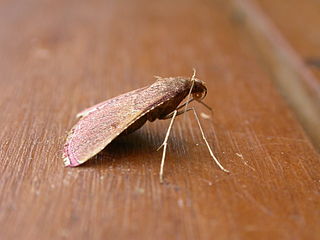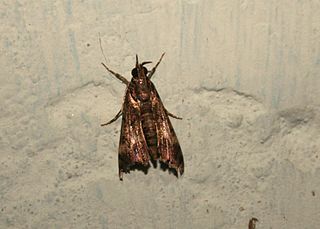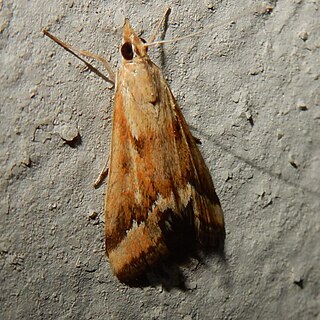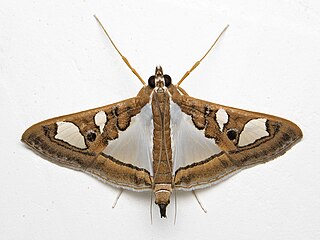
Orphanostigma is a genus of moths of the family Crambidae described by William Warren in 1890.
Luceria is a genus of moths of the family Erebidae. It was described by Francis Walker in 1859. This genus is found in southern Asia, Australia, on several Pacific islands and a few species also in Africa.

Achyra massalis, the ombava, is a moth of the family Crambidae. The species was described by Francis Walker in 1859. It is found in most of the Old World tropics, including Réunion, Namibia and Australia.

Glyphodes negatalis, the karanj defoliator, is a moth of the family Crambidae. The species was first described by Francis Walker in 1859. It has a wide range in the tropics, including South Africa, The Gambia, Mali, India, Sri Lanka, Hong Kong, Japan, and eastern Australia.

Endotricha mesenterialis is a species of snout moth in the genus Endotricha. It was described by Francis Walker in 1859. It has a wide distribution and is known from Austral Island, Australia, the Kermadec Islands, New Caledonia, New Guinea, Palau, Samoa, Tahiti, Begum Island, Christmas Island, India, Myanmar, Indonesia (Borneo), Malaysia, the New Hebrides, the Nicobar Islands, Sri Lanka, Tonga, Taiwan and China.

Bradina admixtalis is a species of moth of the family Crambidae described by Francis Walker in 1859. It is found in Australia, New Guinea, New Zealand, south-east Asia and the Comoros, Réunion, South Africa as well as India.

Noorda blitealis is a species of moth of the family Crambidae. It is found in subtropical Africa, south of the Sahara and in Australasia.

Banisia myrsusalis, the sapodilla borer or sapota midrib folder, is a species of moth of the family Thyrididae. It was described by Francis Walker in 1859 and is found in North America, Brazil, Australia, southern Asia and Africa.

Achyra coelatalis is a species of moth in the family Crambidae. It was described by Francis Walker in 1859. It is found in Botswana, the Democratic Republic of the Congo, Ghana, Kenya, Réunion, Lesotho, Madagascar, Namibia, Niger, the Seychelles, South Africa, Tanzania, Zambia, Zimbabwe, Australia, India and Sri Lanka.

Glyphodes pyloalis, the lesser mulberry snout moth, lesser mulberry pyralid or beautiful glyphodes moth, is a moth in the family Crambidae. It was described by Francis Walker in 1859. It is found in Iran, China, Japan, India, Indonesia (Sumatra), Sri Lanka, Taiwan, the Democratic Republic of the Congo, Equatorial Guinea, Mozambique and North America, where it has been recorded from Florida, Maryland, North Carolina, South Carolina and Virginia.
Herpetogramma piasusalis is a species of moth in the family Crambidae. It was described by Francis Walker in 1859. It is found in Australia, where it has been recorded from Queensland. It has also been recorded from Indonesia (Java), Kenya, Madagascar and Zambia.
Herpetogramma stultalis is a species of moth in the family Crambidae. It was described by Francis Walker in 1859. It is found in Malaysia, India, Sri Lanka, China, Japan, Pakistan, Papua New Guinea and Australia, where it has been recorded from Queensland. In Africa, it has been recorded from the Democratic Republic of the Congo and Réunion.
Omiodes poeonalis is a moth in the family Crambidae. It was described by Francis Walker in 1859. It is found in the Democratic Republic of the Congo, Sierra Leone, Tanzania, the Chagos Archipelago, China, Indonesia, Sri Lanka, Japan and Australia (Queensland).
Orphanostigma vibiusalis is a moth in the family Crambidae. It was described by Francis Walker in 1859. It is found in the Democratic Republic of the Congo, southern India, Malaysia and Myanmar.
Pardomima amyntusalis is a moth in the family Crambidae. It was described by Francis Walker in 1859. It is found in the Democratic Republic of the Congo, Ivory Coast, Kenya, Madagascar, Mozambique, Sierra Leone, Uganda, Zambia, Sri Lanka, India, Indonesia (Java), Myanmar and Australia, where it has been recorded from Western Australia.

Patania sabinusalis is a species of moth in the family Crambidae. It was described by Francis Walker in 1859. It is found in Australia, Cameroon, the Democratic Republic of the Congo, Kenya, the Seychelles, Somalia, Uganda, Zambia, Sri Lanka, India, Borneo, Java, Fiji, New Guinea, Samoa, the Solomon Islands, Taiwan and Japan.

Spilomelini is a tribe of the species-rich subfamily Spilomelinae in the pyraloid moth family Crambidae. The tribe was erected by Achille Guenée in 1854.












